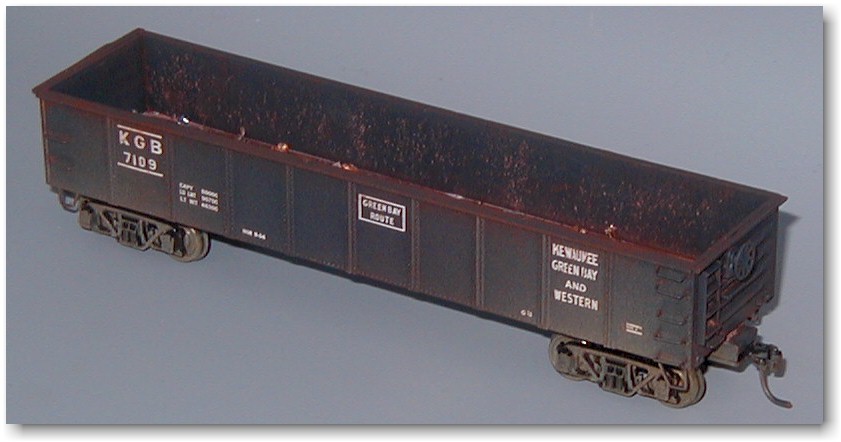|
I glued the underbody to the plastic body with Zap
CA and added the brake wheel to the end of the car body. The basic
car was ready for the paint shop. I gave it a coat of Modelflex
#16-05 Weathered Black and then some Gloss #16-603 in the
locations where I would be decaling.
The car had the standard GB&W lettering used in the 1950s
and 1960s, so I was able to use a Scale
Rail Graphics GBW/KGB 40' wood boxcar decal set to letter the
car. These decals are very thin and I had troubles with the large KEWAUNEE GREEN
BAY AND WESTERN decal; it took several attempts
to get one of those decals down without tearing. By the end of the
second side of the car I developed the technique of putting the
dry decals down on the car side and then using a wet Q-Tip to
release the backing paper. (Andy gave me some decal tips after
that so I hope things go better with future projects.)
The car number was cut from the boxcar number set, using the
middle digits of an "8100" from the set and then adding
a "7" to the left and an appropriate finishing number,
remembering that the KGB cars were odd numbers only.
Andy and I used two photos to determine the positioning of the
lettering. Interestingly enough, the cars were lettered
differently! KGB 7177 had the CAPY data
below the road number in the second panel, while 7195 had that
data on the third panel. Andy and I both chose to model our cars
after the 7195 style, as that was the later photo and matched the
other open-topped cars better.
I used the largest dimensional data in the Scale Rail Graphics
set for the car; again, this was a "close enough"
decision. A Microscale or
similar set could be used to get more exact data but considering
the accuracy of the basic car body and the scale I had no problem
with using the SRG data.
My favorite use of the SRG set was to cut out letters from some
end reporting marks to add a GB AAR code to
each side of the car. The CALDWELL SNUBBER
lettering from the decal set was used as a filler in the far right
panel of each side and a NOR 9-54 shop
date completed the "close enough" lettering. Two
applications of Microscale
Micro-Sol set the decals in place.
|


